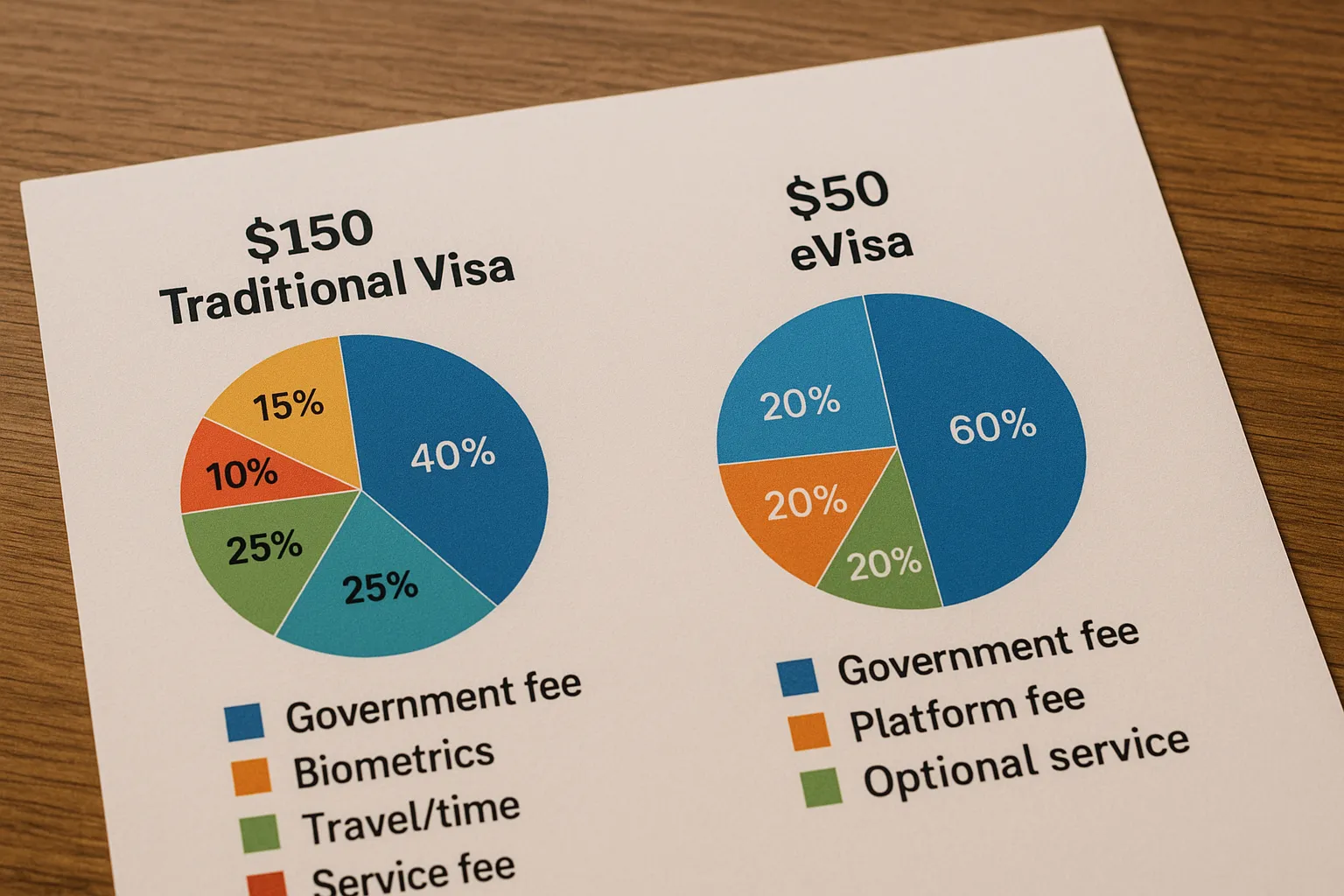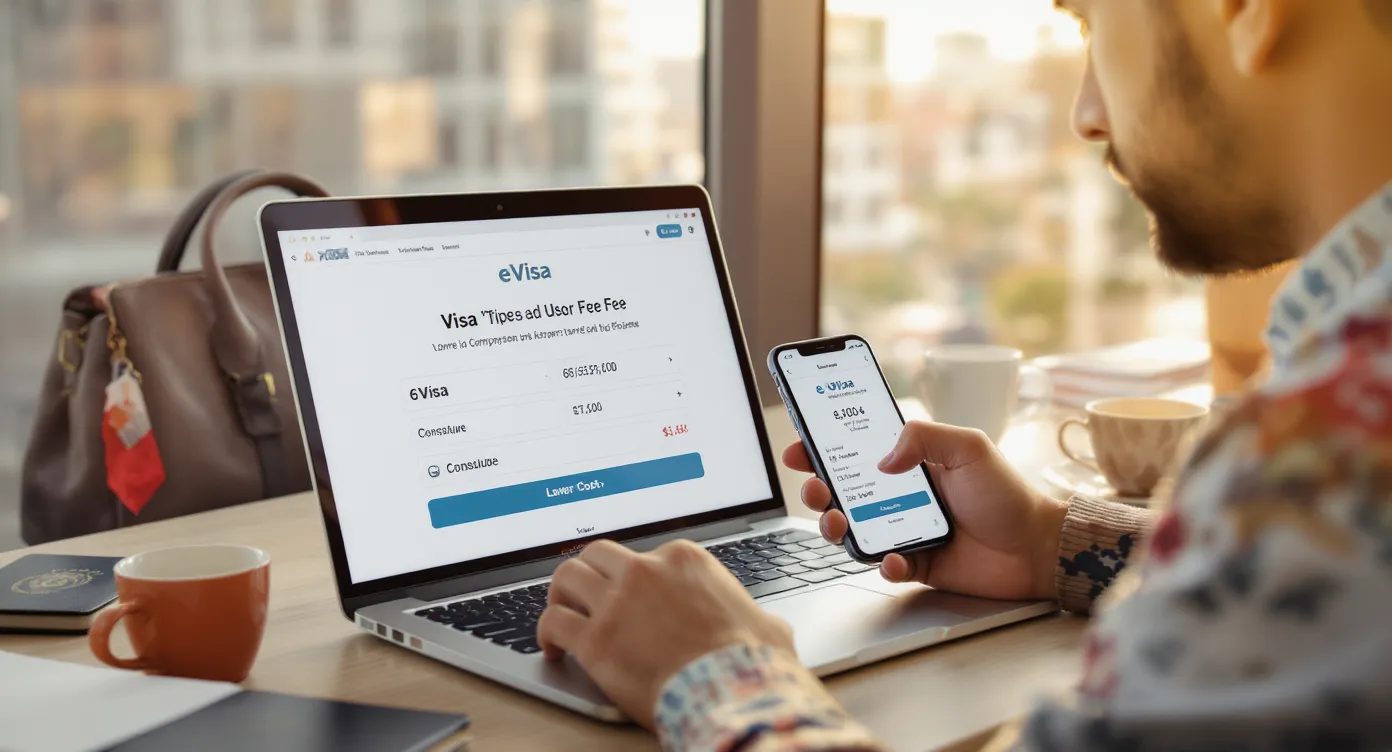Fee for Visa: How Costs Are Calculated

Visa prices can feel like a moving target. One traveller pays $35, another is quoted $160, and a third discovers an extra “expedite” charge at the checkout screen. What’s going on? Below, we peel back the layers of a typical visa bill so you know exactly where every dollar goes—and how to keep surprises to a minimum on your next trip.
1. Government-Imposed Fees
The largest slice of any visa cost is set by the destination country. These fees fall into three broad buckets:
| Fee Type | What It Covers | Typical Range* |
|---|---|---|
| Application or Consular Fee | Document checks, security screening, issuance | $20 – $200 |
| Reciprocity (or “visa issuance”) Fee | Charged only to nationals of countries that impose similar fees in return | $0 – $250 |
| Border-Control Surcharge | Infrastructure & security at ports of entry | $5 – $40 |
*Based on published 2025 fee schedules for 30 popular destinations.
A U.S. citizen applying for a Turkish eVisa, for example, pays a $50 application fee and no reciprocity charge, whereas an Argentine passport holder pays $20. Conversely, the U.S. E-2 investor visa carries a $205 application fee plus a $105 reciprocity fee for French applicants but $0 for Japanese nationals.
Why do fees change so often?
- Exchange-rate adjustments – Many governments set fees in local currency; consulates abroad convert them quarterly.
- Security upgrades – Biometric capture and database connections raise per-applicant costs.
- Political reciprocity – A fee hike in one country is often mirrored by partners within months.
2. Processing Speed Add-Ons
Governments increasingly offer tiered timelines. India’s eVisa portal, for instance, advertises:
- Standard (3–5 business days): $25
- Urgent (24–48 h): $40
- Super-urgent (≤24 h): $60
Paying more never guarantees approval—it only moves your file higher in the queue. If your travel date is at least two weeks away, stick with standard processing and pocket the savings.
3. Biometric & Compliance Charges
Visas that require fingerprints, digital photos or on-site interviews often carry separate biometric fees. The UK ETA, launching in 2025, is an exception: fingerprints are not collected, so the price stays at a flat £10 (~$13). In contrast, the U.S. E-visas add a $85 biometrics fee on top of the DS-160 application cost.
4. Optional Service & Platform Fees
Electronic systems are convenient, but running secure cloud infrastructure, payment gateways and 24/7 support generates costs. Platforms generally monetise in two ways:
- Official portals – A small technology surcharge (e.g., Kenya’s $1.50 card-processing fee).
- Private facilitators – End-to-end assistance, error checking and live chat for an added $20 – $100.
SimpleVisa keeps this layer low by automating form-filling with passport OCR and real-time validation—one reason our partners see approval rates above 95%.
5. Hidden & Indirect Expenses
Even when the government fee is modest, other costs can creep in:
- Courier postage if physical documents or passports must be mailed.
- Translations/notarisations for birth certificates or bank statements (commonly $15–$30 per page).
- Travel to a consulate for in-person appointments—think time off work, flights or hotel nights.
Switching to an eVisa where available eliminates nearly all of these extras. (See our guide to the countries that accept electronic visas for 2025.)
6. Cost Breakdown: Traditional Visa vs eVisa
| Component | Embassy Sticker Visa | Electronic Visa (eVisa) |
|---|---|---|
| Base government fee | $60 | $30 |
| Biometrics/interview | $85 | $0–$15 |
| Courier/Postage | $25 | $0 |
| Time off work (1 day) | $200 (avg. salary loss) | $0 |
| Third-party service (optional) | $50 | $25 |
| Estimated Total | $420 | $70 |
Result: Travellers save up to 80% by choosing a digital route where eligible. No wonder our post on the benefits of electronic visas is one of the most read on SimpleVisa.

7. How Airlines & OTAs Display Fees
Under new consumer-protection rules in the EU and Australia, ancillary visa prices must be shown upfront during ticket purchase. However, many booking engines still separate “mandatory government cost” and “service fee” in small print.
If you’re a travel brand, embedding a single all-inclusive price in your booking flow lifts conversion by 12–15% according to SimpleVisa partner data. (See our Ultimate Guide to Marketing eVisa Services During the Booking Flow.)
8. Five Ways Travellers Can Save
- Apply early – Avoid paying for expedited handling.
- Check reciprocity tables – A second passport could slash costs for dual citizens.
- Use official payment channels – Dodgy third-party sites often add hidden mark-ups. Learn to verify authentic visa websites.
- Bundle with travel insurance – Some insurers rebate part of the visa fee if your trip is cancelled.
- Claim business deductions – In many jurisdictions, work-trip visa costs reduce taxable income.

9. Forecast: Fee Trends for 2026–2027
- Flat-rate digital permits: More countries will copy the UK ETA’s single-price model.
- Dynamic pricing: Expect off-peak discounts to spread, mirroring airline yield management.
- Carbon offsets: A handful of island nations plan to embed $5–$10 eco-levies into visa fees to fund climate resilience.
Staying informed helps you budget accurately. Subscribe to SimpleVisa Alerts for real-time updates on fee changes, processing times and new eVisa launches.
Frequently Asked Questions
Do I pay the visa fee if my application is rejected? In almost all cases, yes. Processing starts the moment you submit, so fees are non-refundable.
Are children charged the same amount? Many countries charge reduced or zero fees for minors under 16, though biometrics may still apply from age 12.
Can I pay one fee for multiple entries? Some visas (e.g., U.S. B1/B2) allow multiple entries within their validity at no extra cost. Others, like India’s eVisa, require a new fee once the previous visa expires, even if unused.
Is the service fee compulsory? Only the government portion is mandatory. You can self-apply on official portals, but professional services add convenience and reduce error-related refusals.
Why does the website show a ‘processing fee’ after I’ve already paid? That second charge is often for payment-gateway or technology costs. Reputable sites disclose it before checkout; hidden fees are a red flag.
Ready to Eliminate Guesswork?
Whether you’re a traveller tired of puzzling fee tables or a travel brand losing bookings to sticker shock, SimpleVisa simplifies the entire cost equation. Our API and white-label flows surface total visa pricing—including government, biometric and service components—right inside your booking path. No hidden extras, just transparent numbers your customers can trust.
Book a 15-minute demo at simplevisa.com and discover how easy, predictable and profitable visa processing can be.